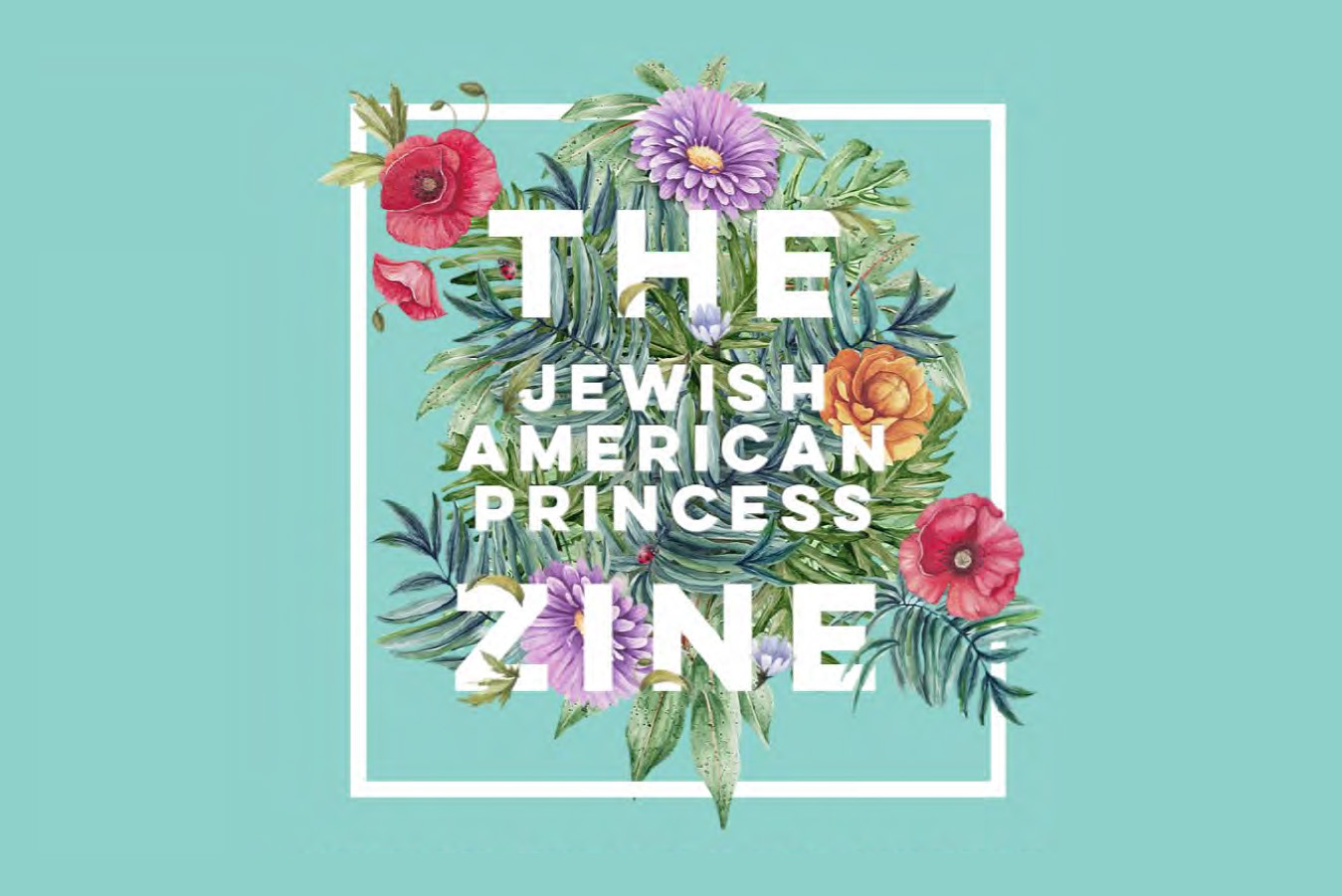Welcome to the Jewish Underground Press! The first review in a new column about Jewish zines, Miranda Sullivan revisits “The Jewish American Princess Zine” by Julie Weinberg-Connors through a new lens, four years after its publication in 2017. You can read our columnist’s introduction to our zine review series here.
Gretchen Weiners. Rachel Green. Cher Horowitz. These are media figures many a Jewish women have been compared to. They are often all we have for representation (sans Broad City). They are Jewish American Princesses.
In The Jewish American Princess Zine, Julie Weinberg-Connors seeks a modern understanding of the Jewish American Princess. Weinberg-Connors humanizes the Jewish American Princess as misunderstood by using an extensive, mostly accurate history of antisemitism and sexism against Jewish women. She argues that the stereotype is classist, racist, sexist, and antisemitic. Weinberg-Connors concludes by suggesting it may be radical to love the Jewish American Princess, and that we should focus on critiquing the aspects of the Jewish American Princess that are problematic without criticizing the Jewish American Princess herself.
But why can’t we? Humanizing the Jewish American Princess rewrites how Jews have benefited from white privilege. While the Jewish American Princess has been weaponized by non-Jews for antisemitic purposes, intracommunally it’s often been used as a caricature to make fun of classist and racist Jewish people. We should allow ourselves as Jews to critique Jewish people manipulating capitalism to gain increased access to whiteness, just as the Jewish American Princess is characterized by doing and criticized by those in the Jewish community.
In the zine, Weinberg-Connors explores the stereotype of wealthy Jewish women who use their proximity to whiteness to gain further access to power. Reading the Jewish American Princess Zine in 2021, after initially reading around the time of its release in 2017, made me sit with two things: One, that we should be able to recognize our privileges as white Jews while acknowledging the collective trauma from Christian fascist antisemitism without being anti-Black and two, if the Jewish American Princess is a caricature to make fun of classist, and racist, Jewish people, why do we care to understand her only to excuse what her behavior represents?
In the United States, Ashkenazi Jews are familiar with the idea of suspension. White Ashkenazi Jews maintain suspension between privileged and persecuted, perhaps knowing but unsure of how to make change. Yet, when we understand our position of suspension in this world, we gain power to challenge such a system. White supremacy operates on the assumption that white Jewish people will be too preoccupied with their own privileges to want to abolish white supremacy or, god forbid, stand in solidarity with the Black community, some of which are also in the Jewish community. We hold the history of discrimination, pogroms, and holocaust but in America, white Ashkenazi Jewish people have built-in privileges from their phenotype. White Jews who hide behind their Jewishness to deny their own anti-Black racism do not realize that in America, simply not being Black is more important to the American social hierarchy than any pogrom our families may have gone through. This is not to discount Jewish experience or rank oppression. It’s just that when Jewish people ignore their white privilege, not only does it diminish the experiences of Black Jews, but they misconstrue white supremacy to erase themselves from the history of white Jewish people benefiting from American settler colonialism.
We cannot use pity for the Jewish American Princess to stop antisemitism and misogyny. I agree with Weinberg-Connors that there is a systemic problem (capitalism), but if we really want to understand the Jewish American Princess, we have to delve into what white Jews gain when they are granted increased proximity to whiteness.
It is disappointing to say, but in her explanation of the Jewish American Princess, Weinberg-Connors fails to do exactly what she claims she is doing over and over again: face the privilege of whiteness. The zine was too broad reaching at points, and missed an opportunity to present an in-depth analysis of white supremacy. There are undoubtedly antisemitic and sexist attributes about the Jewish American Princess stereotype, but Weinberg-Connors misconstrues the problems with the term. It’s not that Jews are perpetuating antisemitism, it’s that non-Jewish people can take terms coined by the Jewish community to purport their own antisemitic beliefs. Much like the label of “Karen”, the intention of a Jewish person labeling someone as Jewish American Princess -y may not be to vilify Jewish women, but to call out Jews who see their whiteness and class status in America as opportune.
I would’ve been more forgiving about all this empathy towards Jewish American Princesses had it not been for some contradictions in Weinberg-Connors’ discussion of the racial politics of Jews, and the history of Jews and race in America. Weinberg-Connors acknowledges that some Jews have white privilege even dating back to the colonial period in which some Jewish families owned slaves. But she then suggests that Jews did not have access to whiteness until much later in history: “Jewish people believed that money would give them access into the goy [non-Jewish] world, but it did not work out that way until the 1950s.” This statement simplifies the history of Jewish assimilation into whiteness and demonstrates my earlier lamentation of Jews disqualifying themselves from perpetuating racism because of the perception that Jews have suffered as much as Black people in America. The system of white supremacy allows power to some to maintain anti-Black policies, ideas, and actions. While most Jewish people in America today are not descendants of slave owners, some Jews have been granted the privilege of explicitly anti-Black power simply by being considered white. By equating these histories, we ignore that and discount the ingrained anti-Blackness a Jewish American Princess holds within her, and the experiences of Black Ashkenazi Jews. Weinberg-Connors says, “the racial differentiation of Jews is viewed through its proximity to Blackness.” When a Jewish American Princess schedules a nose job or straightens her hair it dovetails internalized antisemitism with an inherent anti-Blackness.
Considering the political climate at the time of publication, the first year of Donald Trump’s presidency, Weinberg-Connors suggests that white privilege will not continue to protect white Ashkenazi American-Jews in a Trump America. In 2021, we are still living in a country run by evangelical quasi-fascists who grant privileges to Jews and other “model minorities” to posit Black people as lazy, and to maintain power. However, after four years of Trump, and one year post George Floyd’s murder, we are well beyond the point of equating White Ashkenazi struggle to anti-Black police violence, prisons, and the American injustice system.
The contradictions continue: Weinberg-Connors states that through efforts to access Whiteness through assimilation, Ashkenazi Jews become agents of white supremacy. I wrote in my margins, “We finally got there!” but Weinberg-Connors softens the statement in the next paragraph by saying the Jewish American Princess is totally constructed in our minds, which it is my belief that she is not. Can we blame the Jewish American Princess in her entirety for her racism? No, but we don’t have to exactly be 100% forgiving towards her either. Why give space for mediocrity and allow this racism? What do we gain from this?
Jewish American Princesses exist! Put aside any thought that I just have too much internalized antisemitism and sit with the idea that Jewish American Princess-hood is not a stereotype constructed in our minds; there are Jewish people who know their position as white people, use it to gain wealth, and then flaunt their excess in the hopes of fully assimilating into American consumerist society. The stereotype makes fun of Jewish people who exploit the material wealth that American white supremacy grants them. In Weinberg-Connors zine, we’re given a fairly comprehensive history of the racism, classism, and misogyny of the term. While the stereotype of the Jewish American Princess plays off of negative stereotypes about Jewish people, I do not care to understand Jewish people who use their vicinity to whiteness to fulfill a perverse aspiration of American imperial capitalism.
One of the problems with the Jewish American Princess stereotype is that non-Jewish people use it to portray all Jewish women or assume that’s how all Jews act. The Jewish American Princess zine at times felt like a validation for white Jews who dis-identify as Jewish American Princesses. In the zine, the Jewish American Princess is posited as a victim of racism, sexism, and classism, but I’m worried that the omission of the ways in which Jews actually perpetuate such -isms exonerates those readers from their role in maintaining them. Instead, they need to take ownership over their privilege and not misremember history.
White Jews cannot get too comfortable blaming the Jewish American Princesses for racism in the Jewish community. If we spend too much time empathizing with the Jewish American Princess, it is just another form of Jewish people wanting to cozy up to white, moneyed elites, just as one may criticize the Jewish American Princess herself for doing. Weinberg-Connors excuses the Jewish American Princess’ behavior by claiming that the Jewish American Princess is merely a product of middle-class consumerism. But it comes down to a question of accountability. Should we excuse the capitalist behavior of white Jews or work towards a united, anti-racist Jewish community? If people cannot let go of their dreams of American assimilation, they can’t be in solidarity with marginalized people or anti-capitalist movements.
I wish Weinberg-Connors had come to a different conclusion because I think she begins to explore a lot of important ideas. While we should understand the ways in which Jewish women are victimized by stereotypes, it is legitimate to criticize Jewish American Princesses and the values they represent. The ultimate conclusion to this zine should have been this: we can criticize what Jewish American Princesses stand for and consider all the nuances of the term, but we have to hold our community accountable for consumerist White American aspirationalism. We can reject the Jewish American Princess and capitalism and not misconstrue white Jews’ role in white supremacy. Perhaps when we do that, the stereotype of the Jewish American Princess will only exist in history books.

